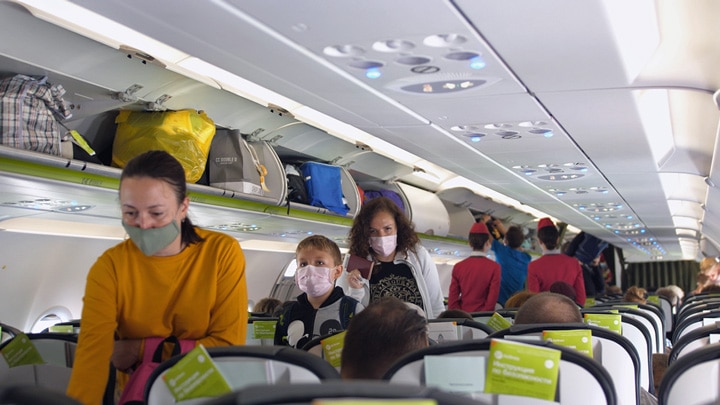
(mariyaermolaeva / Shutterstock.com)
Royal NLR, together with RIVM, has investigated the risk of a passenger being infected by inhaling the corona virus on board an aircraft. Measures are already in place that reduce the chance that an infectious passenger will board the plane. If this person is nevertheless in the cabin, fellow passengers within a section of seven rows – around the contagious passenger – run a relatively low risk of COVID-19 on average. Lower than, for example, in unventilated rooms of the same size.
Various measures apply within the Dutch aviation sector to prevent a passenger from becoming infected with COVID-19 (corona virus disease 2019) boarding an aircraft. For example, a health declaration is mandatory for all air travelers and travelers from very high-risk areas are subject to an additional antigen rapid test obligation of no more than 24 hours before boarding. Passengers may not be allowed on board aircraft without a negative test result.
With a low prevalence of the virus at the place of departure and a negative test result before boarding, the chance that an infectious passenger will board is small. In the unlikely event that an infectious person is on board, various factors influence the possible spread of the virus in aircraft.
To assess the risks of COVID-19 on board aircraft, Royal NLR – Netherlands Aerospace Center and the National Institute for Public Health and the Environment (RIVM) have carried out a scientific study commissioned by the Ministry of Infrastructure and Water Management. It has been assumed that the corona measures for the aviation sector, such as wearing mouth masks, will be observed. The risk of disease as a result of aerosolized SARS-CoV-2 virus particles has been investigated (severe acute respiratory syndrome coronavirus 2), emitted by an infectious passenger in an airplane cabin. In this study, transmission of the virus through direct contact and surfaces was not investigated.
Conclusions
Various situations were assessed on the basis of measurements and simulations. With a typical cruising flight duration for each of the aircraft studied, the risk of COVID-19 from inhalation of virus particles by passengers in the seven rows surrounding the infectious passenger was estimated to be 1:1800 to 1:120. In the case of a super shedder – a person who excretes on average 300 times as many virus particles – average risks increased from 1:370 to 1:16. According to the report, these types of biomedical aspects have the greatest impact on risk. Risks also increase with longer flight duration. Wearing a face mask on board reduces the risk.
The research results show that the risk decreases with a greater distance from the infectious passenger. Therefore, the report assumes that passengers sitting further than 3 rows away from the contagious passenger are not at risk. The researchers estimate that between 2 and 44 cruise flights, the presence of a 'regular' infectious passenger may result in at least 1 case of COVID-19. For a super shedder, that risk is estimated at 1 to 9 flights. These figures apply to the situation in which an infectious passenger is present in the aircraft cabin. The likelihood of this depends, among other things, on the number of persons infected with SARS-CoV-2 in the population and whether or not a negative test result is required to be allowed on board. Based on figures from June 7 and a test requirement, the researchers estimate that there could be an infectious passenger on board every 11 to 33 flights. Of those passengers on board, it is estimated that less than 3% are super shedders.
- You can download the report here: https://reports.nlr.nl/handle/10921/1568
- In anticipation of this study, NLR produced an inventory of High Efficiency Particulate Air filters (HEPA) in July 2020, with the conclusion that 99,1% of the flight movements conducted to and from Dutch airports in 2019 are very likely to be these have been carried out by aircraft with HEPA filters on board (see here).


I'm afraid it will be a long time before the face mask obligation is abolished on the plane. To Thailand twelve hours on such a thing, plus the hours at the airport, I can't keep up.
Those face masks on the plane are here to stay for the first few years. I bought new glasses from Hans Anders yesterday. shop like now) But in the room where the eye test is done they stay there for an unlimited time.
Just like in all rooms where people sit close to each other. We will enjoy this for a long time to come. If we get rid of it, we will be many years further, I think.